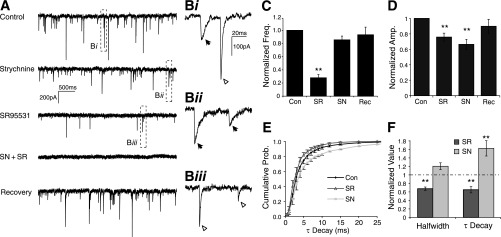Fig. 9.
Spontaneous postsynaptic currents are modulated by blockade of both GABA and glycine receptors. A: representative 5-s epochs of spontaneous (s)IPSC records in each experimental condition. B: expanded 100-ms segments from the traces in A showing condition dependent decay kinetics. Bi: control condition showing heterogeneous kinetic profiles including slow arrow and fast arrowhead events. Bii: isolated GABAergic sIPSCs tended to have slower kinetics (quantified in F). Biii: isolated glycinergic sIPSCs had faster kinetics. C: population data for normalized frequency of sIPSCs. Frequency was significantly reduced during application of SR95531 but not strychnine. D: population data for normalized amplitude of sIPSCs. Both SR95531 and strychnine significantly reduced sIPSC amplitude when bath applied. E: cumulative probability analysis of τdecay values revealed a monophasic rise in control conditions that was significantly shifted to shorter or longer values in SR95531 and strychnine, respectively (P < 0.01, Kolmogorov-Smirnov test). F: quantification of kinetic measures show a decrease in halfwidth and τdecay values in SR95531 and an increase τdecay values in strychnine. Strychnine did not significantly change halfwidth. *P < 0.05, **P < 0.01, significantly different from control; pooled data include both sIPSCs and miniature IPSCs.

